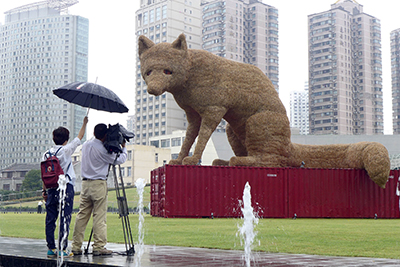
The 7-metre high ‘Urban Fox’ is one of Alex Rinsler's artworks adding a fragment of the wild to the city of Shanghai in China. |
Bold, bright, and beautiful public art sculptures are in the inception phase at the university’s Bloemfontein Campus. Manchester-based public artist, Alex Rinsler, of the Programme for Innovation in Artform Development (PIAD)’s forum for artist development, is to install three enthralling sculptures in the city of Bloemfontein.
The PIAD forum for artist development is an initiative of the Vrystaat Arts Festival, formerly known as the Vryfees, which aims to celebrate art in the Free State by hosting experimental art practices. In its capacity as a PIAD partner, the University of the Free State promotes increased access to, and participation in, culture as a form of human development.
Presenting an artist’s talk titled ‘Urban Safari: Art in public space,’ on the Bloemfontein Campus recently Rinsler introduced himself and his creative ideas to students, staff, and the public at the Johannes Stegman Art Gallery. The talk served as an invitation to the active participation of Bloemfontein citizens in all phases leading to the installations. Dispersed across the Mangaung Metropolitan, the giant sculptures are intended to capture and reflect different aspects of the community’s lived experiences.
As a public artist based in the United Kingdom (UK), Rinsler has exhibited in cities nationally and internationally, with the intention of bringing a touch of the wild to urban lives. His vision is to witness the development of cities into cultural boulevards, and explore “what we can do to bring back the sense of nature, the wild” by adding new symbolism to urban lifestyle.
“I believe in creating work accessible to the public, which stimulates conversation,” said the Clore Leadership Programme Fellow (University of Manchester) and Founder of Pirate Technics - an artistic practice company.
In 2012, he worked with 31 Master’s students from 24 countries on an icon for global peace named “Under the Baobab” in London. The colourful and magnificent Baobab tree made from pieces of fabric representing distinct cultures told the story of migration to London.
Rinsler is determined that the Bloemfontein “project, similar to the London installation, will create imagery that people will remember.”
Dr Ricardo Peach, Director of the Vrystaat Arts Festival and PIAD, hopes the project fosters diversity while producing a “communal cultural product."
“What I know about Alex’s work is that he will be working with what he calls a self-selected community, people who are interested in this, and who want to work together to build these sculptures, as part as a process for them to get a sense of where they belong, and their input into the city. It’s about people telling their own stories.”
The public installations are a way of transforming the landscape, and connecting people of “a place like Bloemfontein where communities are often still so divided,” said Peach.